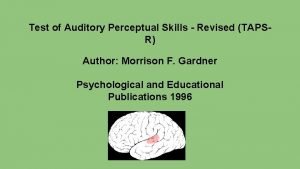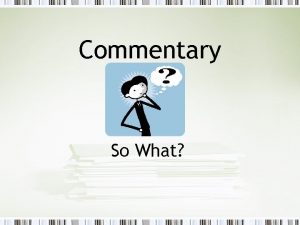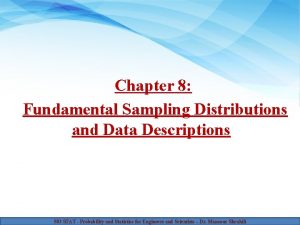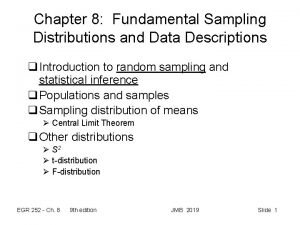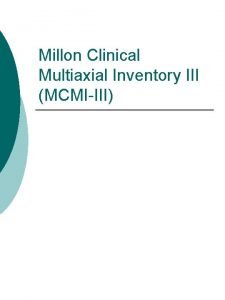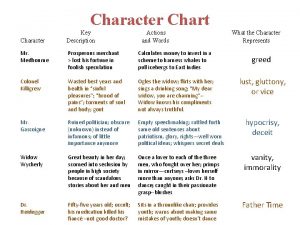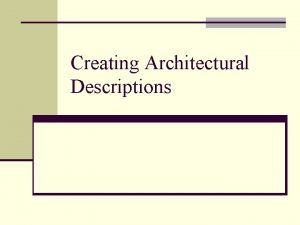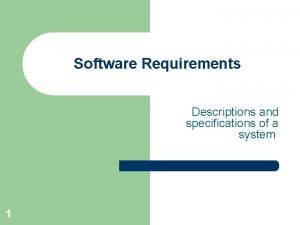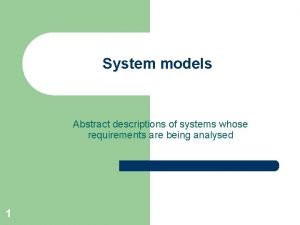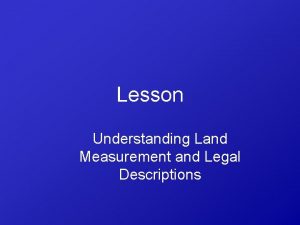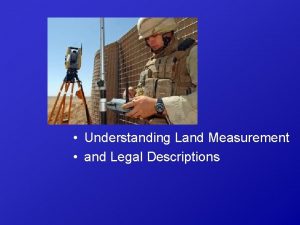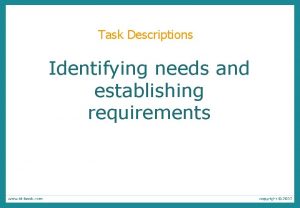Understanding Requirements REQUIREMENTS descriptions of what the system




















- Slides: 20

Understanding Requirements

REQUIREMENTS �descriptions of what the system should do—the services that it provides and the constraints on its operation. �reflect the needs of customers for a system that serves a certain purpose such as: • controlling a device • placing an order • finding information.


Functional & Non Functional Requirements Functional requirements: �Statements of services the system should provide, �how the system should react to particular inputs, and �how the system should behave in particular situations. �the functional requirements may also explicitly state what the system should not do. Non-functional requirements: �Constraints on the services or function offered by the system. They include timing constraints, constraints on the development process, and constraints imposed by standards. �Apply to the system as a whole, rather than individual system features or services.

Functional requirements �what the system should do �depend on the type of software being developed, the expected users of the software, and the general approach taken by the organization �describe the system functions, its inputs and outputs, exceptions, etc. , in detail. �the functional requirements specification of a system should be both complete and consistent For Example: 1. A user shall be able to search the appointments lists for all clinics. 2. The system shall generate each day, for each clinic, a list of patients who are expected to attend appointments that day. 3. Each staff member using the system shall be uniquely identified by his or her eight-digit employee number.

Non-functional requirements �Non-functional requirements, as the name suggests, are requirements that are not directly concerned with the specific services delivered by the system to its users. �They may relate to emergent system properties such as reliability, response time, and store occupancy �Constraints on the system implementation such as the capabilities of I/O devices or the data representations used in interfaces with other systems �Non-functional requirements, such as performance, security, or availability, usually specify or constrain characteristics of the system as a whole. �failing to meet a non-functional requirement can mean that the whole system is unusable.

Non-functional requirements 1. Non-functional requirements may affect the overall architecture of a system rather than the individual components. For example: to ensure that performance requirements are met, you may have to organize the system to minimize communications between components. 2. A single non-functional requirement, such as a security requirement, may generate a number of related functional requirements that define new system services that are required. In addition, it may also generate requirements that restrict existing requirements.


Requirements Engineering �The broad spectrum of tasks and techniques that lead to an understanding of requirements is called “requirements engineering” �Requirements engineering is a major software engineering action that begins during the communication activity and continues into the modeling activity. �It must be adapted to the needs of the process, the project, the product, and the people doing the work. �Requirements engineering provides the appropriate mechanism for understanding what the customer wants, analyzing need, assessing feasibility, negotiating a reasonable solution, specifying the solution unambiguously, validating the specification, and managing the requirements as they are transformed into an operational system.

Tasks to be done in Requirements Engineering �It encompasses seven distinct tasks: 1) Inception 2) Elicitation 3) Elaboration 4) Negotiation 5) Specification 6) Validation 7) Management.

Inception Ask a set of questions that establish: � basic understanding of the problem � the people who want a solution � the nature of the solution that is desired, and � the effectiveness of preliminary communication and collaboration between the customer and the developer

Elicitation Requirements elicitation is the practice of collecting the requirements of a system from users, customers and other stakeholders. �The practice is also sometimes referred to as requirements gathering. �Requirements elicitation practices include interviews, questionnaires, user observation, workshops, brainstorming, use cases.

Problems encountered in Elicitation �Problems of scope. The boundary of the system is illdefined or the customers/users specify unnecessary technical detail that may confuse, rather than clarify, overall system objectives. �Problems of understanding. The customers/users are not completely sure of what is needed, have a poor understanding of the capabilities and limitations of their computing environment, don’t have a full understanding of the problem domain, have trouble communicating needs to the system engineer, omit information that is believed to be “obvious, ” specify requirements that are ambiguous or untestable. �Problems of volatility. The requirements change over time.

Elaboration �Create an analysis model that identifies data, function and behavioral requirements �The information obtained from the customer during inception and elicitation is expanded and refined during elaboration. �Elaboration is driven by the creation and refinement of user scenarios that describe how the end user (and other actors) will interact with the system.

Negotiation �Agree on a deliverable system that is realistic for developers and customers. �Customers, users, and other stakeholders are asked to rank requirements and then discuss conflicts in priority. �Using an iterative approach that prioritizes requirements, assesses their cost and risk, and addresses internal conflicts, requirements are eliminated, combined, and/or modified so that each party achieves some measure of satisfaction.

Specification It can be any one (or more) of the following: � A written document � A set of graphical models � A formal mathematical model � A collection of user scenarios (use-cases) � A prototype It is sometimes necessary to remain flexible when a specification is to be developed. For large systems, a written document, combining natural language descriptions and graphical models may be the best approach.

Requirement Specification Template

Validation �Requirements validation examines the specifications to ensure that all software requirements have been stated unambiguously; that inconsistencies, omissions, and errors have been detected and corrected; and that the work products conform to the standards established for the process, the project, and the product. A review mechanism that looks for � errors in content or interpretation � areas where clarification may be required � missing information � inconsistencies (a major problem when large products or systems are engineered) � conflicting or unrealistic (unachievable) requirements.

Requirements management �Requirements for computer-based systems change, and the desire to change requirements persists throughout the life of the system. �Requirements management is a set of activities that help the project team identify, control, and track requirements and changes to requirements at any time as the project proceeds

Requirements Validation Checklist
 True colors descriptions
True colors descriptions Chapter 8 summary great gatsby
Chapter 8 summary great gatsby Love language example
Love language example Tapsr
Tapsr 6 common phase changes
6 common phase changes Nyseslat performance level descriptions
Nyseslat performance level descriptions Samneric
Samneric Pediatrician job description
Pediatrician job description Basc-3 ages
Basc-3 ages Descripcion personal
Descripcion personal Programer job description
Programer job description Ctopp-2 subtest descriptions
Ctopp-2 subtest descriptions Commentary detail definition
Commentary detail definition Fundamental sampling distributions and data descriptions
Fundamental sampling distributions and data descriptions Sample and population examples
Sample and population examples Case description example
Case description example Is interviews qualitative or quantitative
Is interviews qualitative or quantitative Mcmi
Mcmi Film production hierarchy
Film production hierarchy Celebrity descriptions
Celebrity descriptions Widow wycherly character traits
Widow wycherly character traits



